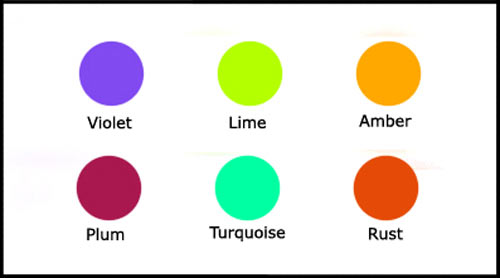

#Example of tertiary colors how to#

Together, they look aesthetically pleasing and produce a calming effect, as opposed to the intensity of complementary colors.

Let’s Make Mud: Understanding and Mixing Complementary Colors.Complementary colors enhance each other’s intensity when placed right next to each other, which is why they’re often used to create bold, high-contrast images that pop. The color wheel is an arrangement of all colors on the spectrum based on their relationships, and it’s useful in creating harmonious color schemes. Oil Painting Techniques: Why We Need Color TheoryĬomplementary colors are hues that contrast with each other and are positioned exactly opposite one another on the color wheel.How to Mix Color: Mixing With Tertiary Colors.There are six in total: vermilion (red-orange), magenta (red-purple), violet (blue-purple), teal (blue-green), chartreuse (yellow-green) and amber (yellow-orange). Sometimes they’re named after the two colors that created them, such as blue-green or orange-red, and sometimes they’re called by their own name. Tertiary colors, also known as intermediate colors, are made by combining equal parts of primary and secondary colors. How to Mix Bright and Dull Secondary Colors.Create Secondary Colors From Multicolored LEDs.For example, combining 1 part red with 1 part blue will create one shade of purple, while combining 1 part red with 2 parts blue will create a darker, more blue-tinged hue of purple. Keep in mind that the ratio of each color you use when mixing them affects the final hue. Red and yellow combine to make orange blue and yellow yield green and red and blue create purple. Secondary colors include orange, purple, and green, and they’re derived from mixing equal amounts of two primary colors at a time. Are Red, Yellow, and Blue Primary Colors?.

In effect, all colors stem from the three primaries. Instead, they combine to create secondary colors, which in turn combine to create tertiary colors. These are colors that can’t be created by mixing of other colors. Primary colors include yellow, blue, and red. Accurately combining colors, using the color wheel, and understanding how colors relate to each other are critical skills for artists, designers, marketers, and brand owners. Color theory is the art of combining colors based on the color wheel, an organized illustration of the primary, secondary, and tertiary colors. If you’re studying fine arts or design as part of a liberal arts degree program, it’s important for you to have a solid command of color theory.


 0 kommentar(er)
0 kommentar(er)
